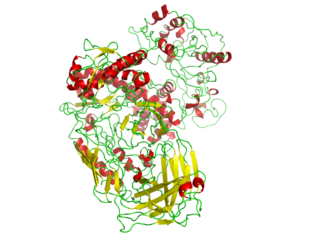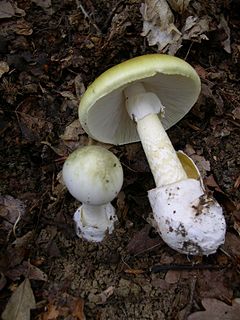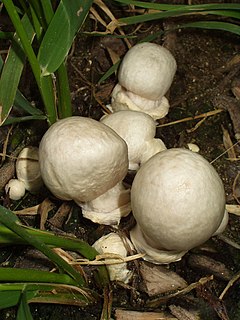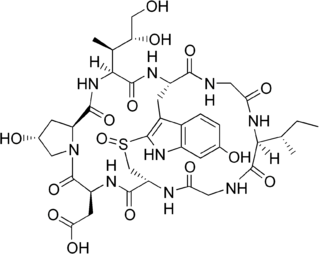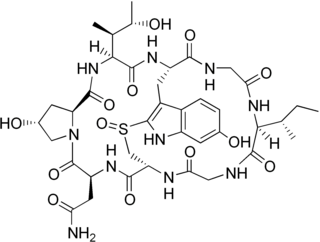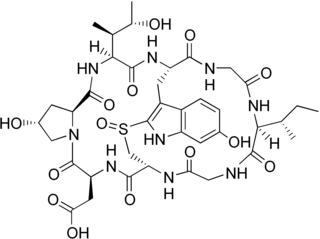 | |
| Names | |
|---|---|
| Other names 2-L-Proline-3-isoleucine-alpha-amanitin | |
| Identifiers | |
3D model (JSmol) | |
| ChemSpider | |
PubChem CID | |
| |
| |
| Properties | |
| C39H54N10O11S | |
| Molar mass | 870.97 g/mol |
| Appearance | Colorless, odorless |
Except where otherwise noted, data are given for materials in their standard state (at 25 °C [77 °F], 100 kPa). | |
| Infobox references | |
Promanullin is a cyclic nonribosomal peptide. It is an amatoxin, all of which are found in the mushroom genus Amanita .

A cyclic compound is a term for a compound in the field of chemistry in which one or more series of atoms in the compound is connected to form a ring. Rings may vary in size from three to many atoms, and include examples where all the atoms are carbon, none of the atoms are carbon, or where both carbon and non-carbon atoms are present. Depending on the ring size, the bond order of the individual links between ring atoms, and their arrangements within the rings, carbocyclic and heterocyclic compounds may be aromatic or non-aromatic, in the latter case, they may vary from being fully saturated to having varying numbers of multiple bonds between the ring atoms. Because of the tremendous diversity allowed, in combination, by the valences of common atoms and their ability to form rings, the number of possible cyclic structures, even of small size numbers in the many billions.
Nonribosomal peptides (NRP) are a class of peptide secondary metabolites, usually produced by microorganisms like bacteria and fungi. Nonribosomal peptides are also found in higher organisms, such as nudibranchs, but are thought to be made by bacteria inside these organisms. While there exist a wide range of peptides that are not synthesized by ribosomes, the term nonribosomal peptide typically refers to a very specific set of these as discussed in this article.
Amatoxin is the collective name of a subgroup of at least eight related toxic compounds found in several genera of poisonous mushrooms, most notably the death cap and several other members of the genus Amanita, as well as some Conocybe, Galerina and Lepiota mushroom species. Amatoxins are lethal in even small doses. Unlike many ingested poisons they are not destroyed by heat so cooking the poisonous mushrooms does not diminish their lethality which can be as little as eating half a mushroom.



